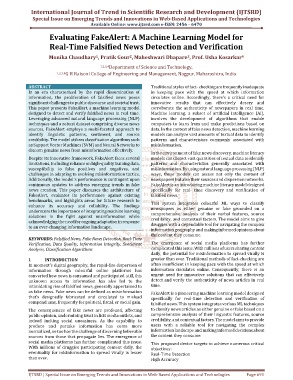Page 701 - Emerging Trends and Innovations in Web-Based Applications and Technologies
P. 701
International Journal of Trend in Scientific Research and Development (IJTSRD)
Special Issue on Emerging Trends and Innovations in Web-Based Applications and Technologies
Available Online: www.ijtsrd.com e-ISSN: 2456 – 6470
Evaluating FakeAlert: A Machine Learning Model for
Real-Time Falsified News Detection and Verification
3
2
Monika Chaudhary , Pratik Gour , Maheshwari Dhapare , Prof. Usha Kosarkar
4
1
1,2,3,4 Department of Science and Technology,
1,2,3,4 G H Raisoni College of Engineering and Management, Nagpur, Maharashtra, India
ABSTRACT Traditional styles of fact- checking are frequently inadequate
In an era characterized by the rapid dissemination of in keeping pace with the speed at which information
information, the proliferation of falsified news poses circulates online. Accordingly, there's a critical need for
significant challenges to public discourse and societal trust. innovative results that can effectively descry and
This paper presents FakeAlert, a machine learning model corroborate the authenticity of newspapers in real time.
designed to detect and verify falsified news in real time. Machine learning, a subset of artificial intelligence (AI),
Leveraging advanced natural language processing (NLP) involves the development of algorithms that enable
techniques and a robust dataset comprising diverse news computers to learn from and make predictions based on
sources, FakeAlert employs a multi-faceted approach to data. In the context of fake news detection, machine learning
identify linguistic patterns, sentiment, and source models can analyze vast amounts of textual data to identify
credibility. The model utilizes classification algorithms such patterns and characteristics commonly associated with
as Support Vector Machines (SVM) and Neural Networks to misinformation.
discern genuine news from misinformation effectively.
In the environment of fake news discovery, machine literacy
Despite its innovative framework, FakeAlert faces several models can dissect vast quantities of textual data to identify
limitations, including reliance on high-quality training data, patterns and characteristics generally associated with
susceptibility to false positives and negatives, and misinformation. By using natural language processing (NLP)
challenges in adapting to evolving misinformation tactics. ways, these models can assess not only the content of
Additionally, the model's performance is contingent upon newspapers but also their sources and dispersion networks.
continuous updates to address emerging trends in fake FakeAlert is an introducing machine literacy model designed
news creation. This paper discusses the architecture of specifically for real- time discovery and verification of
FakeAlert, evaluates its performance against existing falsified news.
benchmarks, and highlights areas for future research to
enhance its accuracy and reliability. The findings This system integrates colourful ML ways to classify
underscore the importance of integrating machine learning newspapers as either genuine or fake grounded on a
solutions in the fight against misinformation while comprehensive analysis of their verbal features, source
acknowledging the need for ongoing adaptation in response credibility, and contextual factors. The model aims to give
to an ever-changing information landscape. druggies with a dependable tool for navigating the complex
information geography and making informed opinions about
the content they consume.
KEYWORDS: Falsified News, Fake News Detection, Real-Time
Verification, Data Quality, Information Integrity, Sentiment The emergence of social media platforms has further
Analysis, Classification Algorithms complicated this issue. With millions of users sharing content
daily, the potential for misinformation to spread virally is
I. INTRODUCTION greater than ever. Traditional methods of fact-checking are
In moment’s digital geography, the rapid-fire dispersion of often insufficient in keeping pace with the speed at which
information through colourful online platforms has information circulates online. Consequently, there is an
converted how news is consumed and participated. still, this urgent need for innovative solutions that can effectively
unknown access to information has also led to the detect and verify the authenticity of news articles in real
intimidating rise of falsified news, generally appertained to time.
as fake news. Fake news can be defined as misinformation FakeAlert is a pioneering machine learning model designed
that's designedly fabricated and circulated to mislead specifically for real-time detection and verification of
compendiums, frequently for political, fiscal, or social gain. falsified news. This system integrates various ML techniques
The consequences of fake news are profound, affecting to classify news articles as either genuine or fake based on a
public opinion, undermining trust in licit media outlets, and comprehensive analysis of their linguistic features, source
indeed inciting social uneasiness. As the capability to credibility, and contextual factors. The model aims to provide
produce and partake information has come more users with a reliable tool for navigating the complex
normalized, so too has the challenge of discerning believable information landscape and making informed decisions about
sources from those that propagate lies. The emergence of the content they consume.
social media platforms has further complicated this issue. This proposed device targets to achieve numerous critical
With millions of druggies participating content daily, the objectives:
eventuality for misinformation to spread virally is lesser Real-Time Detection
than ever. High Accuracy
IJTSRD | Special Issue on Emerging Trends and Innovations in Web-Based Applications and Technologies Page 691

